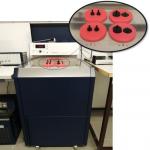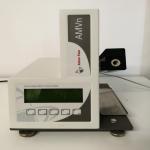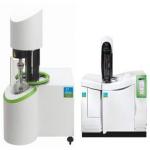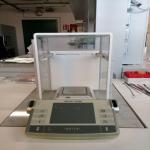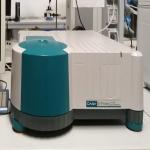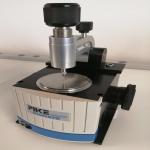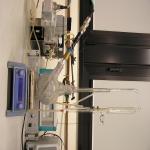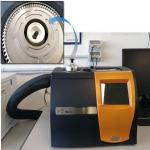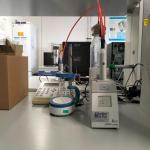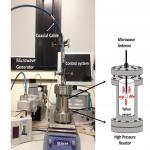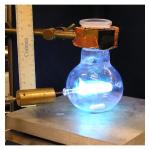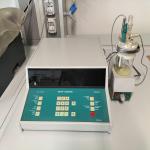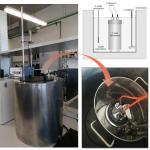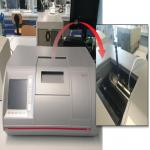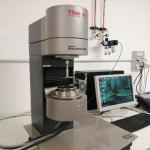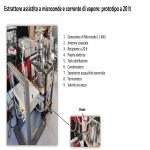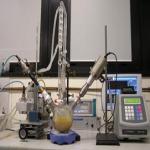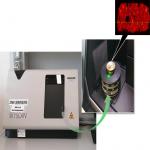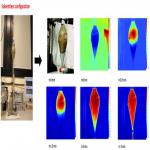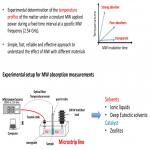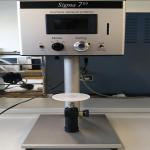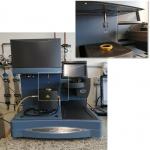Thermogravimetric Analyzer-Gas chromatography/Mass spectrometer
TGA-GC/MS – TGA8000-Claurus 690 GC/Claurus SQ 8T MS (Perkin-Elmer)
Evolved gas analysis performed with a GC/MS system allows both the separation of the mixture of gases produced by the thermal decomposition of the sample and a qualitative and quantitative analysis of each gas.
Types of analysis:
✔ Thermal stability of chemical compounds
✔ Qualitative and quantitative analysis of the decomposition compounds
✔ Studies of the degradation mechanism
Differential Scanning Calorimeter
DSC 250 - Discovery DSC Series (TA Instruments)
Differential scanning calorimeter (DSC) allows to study endothermic (heat absorption) and exothermic (heat production) processes of materials during physical transitions that are caused by phase changes, melting, oxidation, and other kinetic and thermodynamic processes. Moreover, it can be used to measure the heat capacity of materials.
Modulated DSC allows separation of complex and overlapping transitions into more easily interpreted components, increased sensitivity for detecting weak transitions, increased resolution without loss of sensitivity, more accurate measurement of polymer crystallinity, direct measurement of heat capacity.
Types of analysis:
✔ Thermal stability of chemical compounds (Q) (closed pans in a controlled atmosphere)
✔ Thermal stability according to ASTM E537
✔ Specific heat of solid and liquid compounds
✔ Study of phase transitions (melting, evaporation, etc.)
Thermogravimetric Analyzer/Fourier Transform Infrared Spectroscopy
TGA/FTIR - Q5000 IR (TA Instruments)/Cary 640 (Agilent Technologies)
Thermogravimetric Analyzer (TGA) measures the weight change in a material, either as a function of increasing temperature, or isothermally as a function of time, in a controlled atmosphere. It can be used to study the composition of the material and its thermal stability. The TGA technique allows to observe phenomena such as thermal degradation, oxidation, combustion and loss of solvents or water.
In the Hi-ResTM TGA technique the heating rate of the sample material is dynamically and continuously modified in response to changes in the rate of decomposition of the sample (very high heating rates during ramp segments where no weight changes are occurring and slow heating rates during weight changes). Some of the benefits provided by Hi-Res option are improved transition resolution, faster survey scans, enhanced signature analysis capability, transition temperature closer to Isothermal values and increased method programming versatility.
Modulated TGA (MTGATM) allows continuous determination of activation energy, verification of a single kinetic mechanism and verification of first-order kinetic model, in a shorter period of time than the multiple heating rate approach.
Evolved gas analysis (EGA) involves the qualitative analysis of the evolved gas compounds from a TGA experiment. These gas compounds are produced from the decomposition of material, but also from desorption, evaporation, or chemical reactions. They are carried to FTIR instrument via a heated transfer line, performing the compositional analysis in real-time.
Types of analysis:
✔ Thermal stability of chemical compounds
✔ Qualitative and quantitative analysis of the decomposition compounds (TGA/FTIR)
Rheometer
HAAKE RheoStress 6000 (Thermo Scientific)
The HAAKE Rheostress 6000 allow to study the visco-elastic properties of materials. It can work in different mode:
✔ Controlled rate (CR)
✔ Controlled stress (CS)
✔ Controlled deformation (CD)
✔ Combinations of measuring modes
✔ Normal force measurements
The measuring geometry is plate-cone with diameter 60 mm and cone angle of 1°. The temperature is controlled by Peltier and the measurement range is from 10 °C to 80 °C.
Three different test modes can be performed. Flow: continuous rotation of the geometry for viscosity measurement; Oscillatory: oscillation at controlled frequency and amplitude for the measurement of viscoelastic modules; Transitory: sudden change in the conditions of the sample for the measurement of elasticity and recovery.
Compact X-ray micro-CT
SkyScan 1174v2
The SkyScan 1174 is a compact desk-top micro-CT system for material science, industrial, biomedical, and quality control applications. An X-ray tomography system allows us to visualize and measure complete three-dimensional object structures without sample preparation or chemical fixation. The system “SkyScan 1174” allows reaching a spatial resolution of less than 10 μm corresponding to near 1x10-6 cubic mm voxel size. As in the “macro” CT-scanners, the internal structure can be reconstructed and analyzed fully non-destructively.
FT-IR spectrophotometer equipped with ATR accessory
Cary 640 (Agilent Technologies)
GladiATRTM (Pike Technologies)
The GladiATR utilizes a monolithic diamond crystal which can withstand pressure application up to 30,000 psi (2,110 kg/cm2) and provides the ability to fully compress samples to make intimate contact for excellent ATR spectral data. Diamond is compatible with high and low pH samples so the combination of these materials in the GladiATR offers exceptional long-term operation without loss of performance.
UV-visible spectrophotometers
Cary 50 Probe (Agilent Technologies)
A UV-Vis spectrophotometer measures the intensity of light transmitted through a sample compared to a reference measurement of the incident light source. The transmitted light is acquired by a CCD optical detector with a wavelength accuracy of within 0.5nm. It is a powerful technique for determining concentration of analytes in a sample and for tracking chemical reactions. We have single or double ray UV-Vis spectrometers, able to operate in a light range between 200 and 900 nm.
Micro-isothermal titration calorimeter
2277 TAM (Thermometrics)
Isothermal Microcalorimetry is an extremely sensitive technique complementary to differential scanning calorimetry. It works by channeling the heat produced or consumed by a reaction in the sample through heat flow sensors. While the reaction takes place, a reference cell is kept isothermal by a heat sink which is in contact with the TAM III thermostat. Because of the excellent stability of the TAM thermostat, even over long periods of time, TAM maintains outstanding sensitivity. We possess cells to titrate solids, liquids and perfusion cells.
Automated micro viscometer
AMVn (Anton Paar)
AMVn is a falling ball viscometer which measures the rolling time of a ball through transparent and opaque liquids according to Höppler's falling ball principle. Measurement is possible with as little as 150 µL sample volume. Results are given as relative, kinematic, or dynamic viscosity.
Home made coaxial microwave applicator
In collaboration with Dr. Iginio Longo e Carlo Ferrari (INO-CNR) a novel, experimentally simple and versatile method of activation of chemical processes with microwaves (at 2.45 GHz) without a resonance cavity is available. The technology is based on the use of a microwave antenna, namely an open-end coaxial dipole applicator immersed in an ordinary reaction vessel. The procedures adopted in reactions of organic synthesis, extraction of essential oils from plants and photo catalytic mineralization of liquid pollutants have been successfully demostrated. The technology and methodologies are of practical interest for scientific and industrial applications.
Advantages of Coaxial anntena to apply MW in situ
● direct manual/visual/instrumental control of the reaction
● use ordinary glassware, metal vessels/ no vessel
● Easy scale up and safe operation
● Simultaneous use of sensor, MW, US and UV irradiation
Solventless Microwave assisted reactor
An ultrafast and compact solventless MW-assisted reactor is available. The solventless MW-assisted device involves space savings, and involves clean (solventless) and fast processing. Biomasses with high moisture content are ideal candidates to couple with this configuration.
Simultaneous Ultrasounds and Microwaves irradiation reactor
The versatility of the coaxial MW antenna facilitates the simultaneous use of ultrasound and MW energy in an integrated cavity-less device (US-MWHD). Applications like extraction of bioactive compounds from plants, seeds and biomass waste, the simultaneous uses of US and MW also provide an additional decrease in the extraction time. In fact, ultrasound improves the extraction efficiency by increasing the penetration of solvents into plant cells via cavitation, and preventing the degradation of extract.
Integrated UV-MW chemical reactor
A fully integrated photochemical reactor is available. The nonresonant microwave functioning of this photoreactor (cavity-less reactor) enabled us to fully control the physical parameters of the process, such as temperature, UV emission, and MW power. In addition, the MW power is supplied from the interior of the lamp and the reagents, in a reentrant lamp configuration, so that MW radiation is first used to produce the plasma discharge in the lamp, and it then propagates in the sample.
The central position of the two sources (MW and UV light) inside the reactor greatly enchanced the efficiency of the photo catalytic microwave-assisted process, particularly:
● Oxidative decoloration of dyes in wastewater purification
● photocatalytic reactions
● photocatalytic nanoparticles synthesis
● photocatalytic emulsion, dispersion and solution polymerization
Clevenger type Microwave assisted hydrodistillation
A Coaxial MW hydrodistillation extractor is available. This innovative configuration to obtain essential oils from aromatic herbs was inspired by the classical Clevenger hydrodistillation but using a coaxial dipole antenna to apply microwave energy inside the aqueous extraction medium. The method enables us to reduce the heating time and energy demand, compared to the conventional hydrodistillation technique. In addition, it represents a safe and easy alternative approach to scale up the process.
High pressure microwave assisted reactor
A homemade stainless steel pressurized reactor, equipped with a coaxial antenna as a microwave applicator is available. A satisfying MW impedance matching between the reactor and the MW source can be obtained with suitable selection of the configuration of the active section of the applicator, as a function of the permittivity of the reagents.
The reactor is provided with pressure and temperature sensors. A versatile PID control approach is used since the system may operate in two ways: isothermally when the power is regulated or adiabatically when the power is kept constant. This MW-assisted reactor is very suitable for solvothermal processes like mesoporous and microporous materials synthesis and biomass decomposition.
Mahler bomb
Mahler bomb is a calorimeter at constant volume that measures the heat of combustion of a lot of solid and liquid substances. The heat resulting from the combustion reaction of the substance under examination is absorbed by a known mass of water where temperature rise is checked.
Tensiometer
The tensiometer measures the surface or interfacial tension of liquids by Du-Nouy ring or Wilhelmy plate method. The surface tension is a property of a liquid in contact with air or vapor that makes it behave as if it was covered with a thin membrane under tension. It is responsible for the formation of liquid droplets, soap bubbles and menisci. Surface tension is defined as the force acting over the surface of the solution per unit length of the surface perpendicular to the force.
Polarimeter
A polarimeter is a scientific instrument used to measure the angle of rotation caused by passing polarized light through an optically active substance. We have a fully automatic polarimeter, which yields an accurate result within a few seconds, regardless of the rotation angle of the sample. It provides continuous measurement, enabling the measurements of reaction kinetics. In addition, the cell can be kept at the desired temperature through a precise thermostatation system.
Bilancia Mettler Toledo AX 105; d = 0.01 mg/0.1 mg.
The balance can measure small mass, with a sensitivity of 10 µg.
Glass microelectrode (Hamilton, Biotrode238140/05), combined glass electrode (pHC2401-8, Radiometer Analytical), pHmeter and automatic titrator (TIM 900, Radiometer Analytical)
The glass microelectrode allows a rapid and precise pH measurement of a solution. The automatic titrator permits to register the pH variation while performing a titration in solution.
Karl Fischer Coulometer (Metrohm)
The 652 Karl Fischer Coulometer allows to determine the exact quantity of water in a sample by titration with the specific Karl Fisher standard method. It gives accurate and precise results within minutes.








